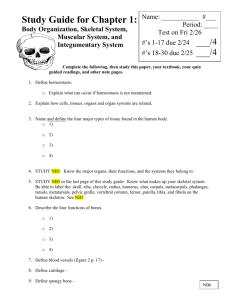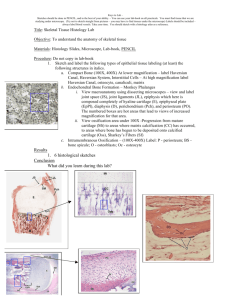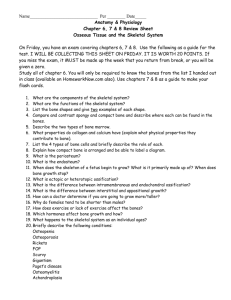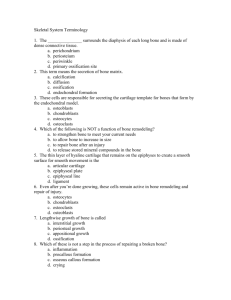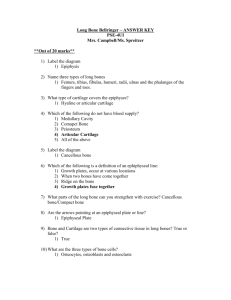File - Shabeer Dawar
advertisement
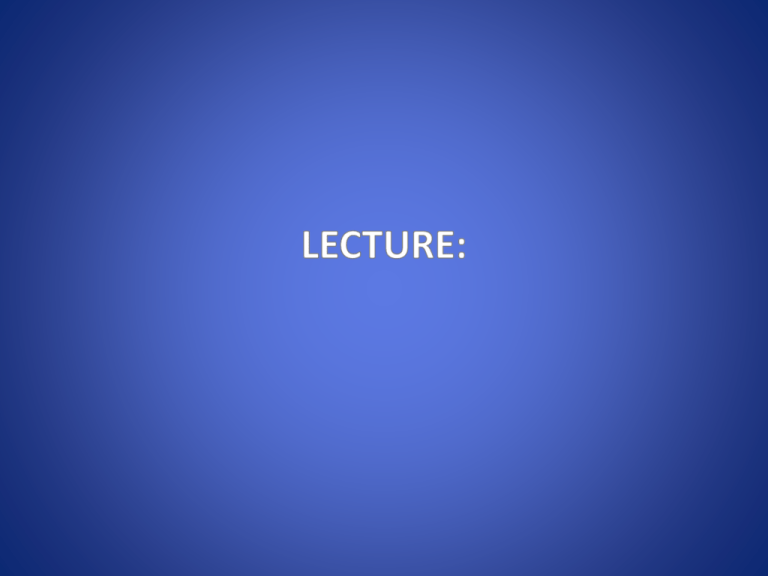
TYPES OF BONES On microscopic examination two types bone tissue can be seen in cross section bone 1.Compact bone: This types appear as dense areas without cavities. 2.Spongy bone: The type in which the bone substance is in the form of slender spicules and trabeculae separated from each other by numerous interconnecting cavities. Examples: • In the long bones the ends(epiphysis) are made of spongy bone covered by thin shell of compact bone. • Shaft are almost entirely composed of compact bone, only a thin layer of spongy bone lines the inner surface of shaft • The short bones consists of a core of spongy bone completely covered by layer of compact bone. • The bones of the skull are composed of two layers(tables) of compact bone, separated by a layer of spongy bone. Microscopic structure of bone • The bone matrix is arranged into lamellae ranging from 3 to 7 micrometer in thickness • Collagenous fibers of a lamellae run parallel to each other, pursuing a spiral or helical course. • Fibers of one lamellae make an angle of 90 degree with those of the others. HAVERSIAN SYSTEM • Bone is traversed by longitudinal channels called Haversian canals. • Lamellae, osteocytes and central haversian canal form a system called haversian system or osteon, the structural unit of bone. • They anastomose with each other by oblique and traverser communications. • Each haversian canal is surrounded by varying number(5-20) of concentrically arranged lamellae of bone matrix, these lamellae are called haversian lamellae. HAVERSIAN SYSTEM • The lacunae of innermost row communicate with the haversian canal from which osteocytes derive their nutrition. • Arranged in longitudinal axis of the bone, in longitudinal sections they appear as long slits bordered by lamellae. • The interval between neighboring haversian systems are occupied by irregular lamellae of bone called interstitial lamellae. • At the periphery of the shaft of a long bone lamellae run parallel to the external surface of the bone which are oriented circumferentially and are called outer or periosteal circumferential lamellae PERIOSTIUM • The thick fibrous sheath which covers a bone except over the articular surfaces is called periostium. • Composed of two layers not sharply defined from each other 1. FIBROUS LAYER: This is outer layer consists of irregularly arranged dense fibrous connective tissue containing many blood vessels 1. CELLULAR LAYER: This is inner layer composed of loosely arranged connective tissue This layer lodges inactive osteoblasts which on stimulation repair the injured bone. SHARPY’S FIBERS: Some of the collagenous fibers of the inner layer penetrate the bone matrix and bind the periostium to the bone and are called sharpy’s fibers. ENDOSTIUM • A very thin layer of connective tissue that lines the medullary cavity and extend as a lining into the canal system of the compact bone is called endostium. • Mainly composed of reticular fibers and reticular cells. • Resting osteoblasts and blood vessels are also present. DEVELOPMENT & GROWTH OF BONE • The process of bone formation is called ossification or osteogenesis which starts in intrauterine life and continues up to puberty. • The bony tissue like other types of connective tissues is derived from mesenchyme • Bones develop from mesenchyme by two methods 1. Intramembranous method 2. Intra-cartilagenous method INTRAMEMBRANOUS METHOD • In this type of ossification the mesenchyme is directly converted into bone without intervening stage of cartilage formation. • This may be called direct method of bone formation. • Begins in the second month intrauterine life. • In the areas where the bone is to be formed the mesenchyme become condensed in the form of sheet or membrane, hence the name intramembranous ossification is given. • Flat bones of the skull, clavicle and bones of face develop by this method. • This mesenchymal membrane becomes highly vascularized at many regions INTRAMEMBRANOUS METHOD • The mesenchymal cells in the center of the vascularized region gradually differentiate into osteoblasts enter such regions are called center ossification. • The osteoblasts in the center of ossification produce a special type of intercellular substance called prebone or osteoid ,a soft and pliable material consists of collagen fibers. • the osteoid is converted into mature bone matrix by deposition of minerals mainly calcium and phosphate. • The process of converting osteoid into bone matrix is known as calcification which occurs under control of alkaline phosphatase secreted by osteoblasts INTRAMEMBRANOUS METHOD • As the bone formation advances at many foci(areas) needle like bone spicules are formed which progressively radiate from such foci. • So initially the bone is spongy consisting of spicules and trabeculae of bone tissue. • Later on some of the spongy bone is replaced by compact bone as the spaces are filled by lamellar bone INTRACARTILAGENOUS OSIFICATION • In this type of bone formation the mesenchyme is first converted into cartilage which serve as temporary supportive framework and this cartilage is then replaced by bone. • This type of bone formation may be called indirect method of bone formation because the cartilaginous stage is present between mesenchyme and mature bone tissue. • This is also called endochondral ossification. • Long bones in fetus are represented by small models of condensed mesenchyme which is soon converted into hyaline cartilage covered by perichondirum. INTRACARTILAGENOUS OSIFICATION The following two basic events occur in intra-cartialgenous ossification 1. Destruction and removal of the hyaline cartilage This applies to all areas except joints surface where hyaline cartilage remains as articular cartilage. 2. Formation of bone tissue in the space formerly occupied by the cartilage • This step is basically similar to intramembranous ossification: transformation of mesenchymal cells into osteoblasts, secretion of osteoid tissue by osteoblast, and conversion of osteoid into bone matrix by mineral deposition. • Here the cartilage is not coverted to bone but is replaced by bone. EVENTS IN INTRACARTILAGENOUS OSSIFICATION PRIMARY CENTER OF OSSIFICATION: • Located in the center of the shaft of bone. In the central region of the shaft of the cartilaginous model of the bone the chondrocytes undergo hypertrophy. • At same time their lacunae also enlarge. • The cartilage forming the walls of the lacunae become calcified, the cartilage cells now disappear leaving their enlarge lacunae vacant PRIMARY CENTER OF OSSIFICATION: • The perichondrium around the primary ossification center changes and becomes periostium as the cells in its inner cellular layer transform into osteoblasts. • The periosteal osteoblasts make a peripheral collar of bone • The bony collar surrounding the walls of the empty and large lacunae of calcified hyaline cartilage is invaded by vascular sprouts from periostium • These sprouts consist of blood capillaries accompanied by mesenchymal cells which continuously divide and transform into osteoblasts EVENTS IN INTRACARTILAGENOUS OSSIFICATION • The osteoblasts excavate passages through the bony collar to pass into the underlying calcified cartilage in the primary center of ossification. • These osteoblasts also erode the calcified cartilage matrix and produce an irregular system of intercommunicating spaces known as primary marrow spaces. • These spaces become filled with embryonic bone marrow EVENTS IN INTRACARTILAGENOUS OSSIFICATION • Formation of bone by osteoblasts in the center of ossification is called interstitial growth • Whereas the deposition of periosteal layers of bone is called appositional growth. • With continuous depositions of sub-periosteal bone ,formation of bone on the walls of centrally placed lacunae stops and a process of erosion starts. • This process of erosion results in removal of early spicules of bone and enlargement of the primary marrow spaces until a primitive medullary cavity is produced in the center of the growing bone EVENTS IN INTRACARTILAGENOUS OSSIFICATION • The process of ossification gradually spread from the primary center of ossification towards the ends of the bone. • Progressively the regions near the primary center of ossification also undergo the above described sequence of changes and the bone formation extend above and below the primary center . • That part of long bone which develops from the primary center of ossification is known as diaphysis. SECONDARY CENTER OF OSSIFICATION • Appear in the cartilaginous ends of the developing bone • The cartilage here is also replaced by bone through the same sequence of events as described for the primary center of ossification • Those parts of the bone that develop from the secondary center of ossification(ends of long bone) are called as epiphysis. • The plate of cartilage intervening between diaphysis and epiphysis is know as epiphyseal cartilage or growth plate. • This plate is responsible for the longitudinal growth of the bone during childhood and early adult age. SECONDARY CENTER OF OSSIFICATION Starting from the epiphyseal side following five successive zones can be recognized in the epiphyseal cartilage 1. ZONE OF RESERVE CARTILAGE: Zone of hyaline cartilage in which the chondrocytes are arranged as groups. 2. ZONE OF CELL MULTIPLICATION: • Here the cartilage cells divide mitotically and become aligned in longitudinal columns. • It is the continuous mitotic division of cartilage cells in this zone which is responsible for the longitudinal growth of the bone. 3. ZONE OF LACUNAR ENLARGEMENT AND CELLULAR HYPERTROPHY: • In this zone the cartilage cells increase in size with corresponding increase in in the size of the lacunae. • Later on the chondrocytes die leaving the lacunae enlarged vacant. SECONDARY CENTER OF OSSIFICATION 4. ZONE OF CARTILAGE CALCIFICATION: In this zone the cartilage matrix which form the walls of the enlarged lacunae becomes calcified. 5. ZONE OF CARTILAGE REMOVAL AND BONE DEPOSITION: • Here the vascular buds from the epiphyseal side approach the epiphyseal cartilage which bring osteoblasts and osteoclasts. • The osteoclasts remove the calcified cartilage and produce bigger spaces. • On the walls of these spaces the osteoblasts align themselves and deposit osteoid tissue which is converted into bone by deposition of minerals. • This zone which is the most active zone of bone growth is also known as metaphysis. SECONDARY CENTER OF OSSIFICATION • When adequate size of the bone has been achieved and no more increases in length is required the chondrocytes of the epiphyseal cartilage cease to divide mitotically and very soon the whole growth plate is replaced by bone and the diaphysis joins the epiphysis. • The junction between epiphysis and diaphysis in later life is indicated by a faint ridge on the outer surface of the bone, this ridge is called epiphyseal line.



